|
Setting
|
....Identify,
retain, and preserve
|
 |
|
recommended.....
|

|
| |
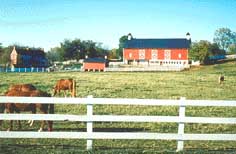
Farm in rural landscape. |
Identifying,
retaining, and preserving building and landscape features which
are important in defining the historic character of the setting.
Such features can include roads and streets, furnishing such as
lights or benches, vegetation, gardens and yards, adjacent open
space such as fields, parks, commons or woodlands, and important
views or visual relationships.
Retaining
the historic relationship between buildings and landscape features
of the setting. For example, preserving the relationship between
a town common and its adjacent historic houses, municipal buildings,
historic roads, and landscape features.
|
|
not
recommended.....
|

|
| |
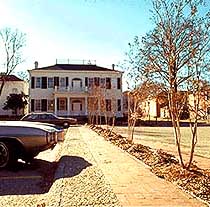
Inappropriate parking that changes the character of an entire neighborhood. |
Removing
or radically changing those features of the setting which are important
in defining the historic character.
Destroying
the relationship between the buildings and landscape features within
the setting by widening existing streets, changing landscape materials
or constructing inappropriately located new street or parking.
Removing
or relocating historic buildings or landscape features, thus destroying
their historic relationship within the setting.
|
|
Setting
|
....Protect
and Maintain
|
 |
|
recommended.....
|

|
| |
Protecting
and maintaining historic masonry, wood, architectural metals, stone,
and plant features through appropriate treatments such as cleaning,
rust removal, limited paint removal, and reapplication of protective
coating systems; and pruning and vegetation management.
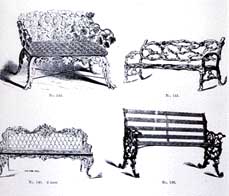
Cast iron furnishings from a 19th-century catalog. |
Protecting
building and landscape features such as lighting or trees, against
arson and vandalism before rehabilitation works begins by erecting
protective fencing and installing alarm systems that are keyed into
local preservation agencies.
Evaluating
the overall condition of the building and landscape features to
determine whether more than protection and maintenance are required,
that is, if repairs to features will be necessary.
|
|
not
recommended.....
|

|
| |
Failing to provide adequate protection of materials on a cyclical
basis which results in the deterioration of building and landscape
features.
Permitting
the building and setting to remain unprotected so that interior
or exterior features are damaged.
Stripping
or removing features from buildings or the setting such as wood
siding, iron fencing, terra cotta balusters, or plant material.
Failing
to undertake adequate measures to assure the protection of building
and landscape features.
|
|
Setting
|
....Repair
|
 |
|
recommended.....
|

|
| |
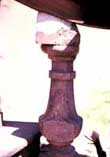
Surviving baluster of terrace that provides a prototype to replace damaged balusters. |
Repairing
features of the building and landscape by reinforcing the historic materials. Repair will also generally
include the replacement in kind--or with a compatible substitute
material--of those extensively deteriorated or missing parts of
features when there are surviving prototypes, such as porch balustrades
or paving materials.
|
|
not
recommended.....
|

|
| |
Replacing
an entire feature of the building or landscape when repair of materials
and limited replacement of deteriorated or missing parts are appropriate.
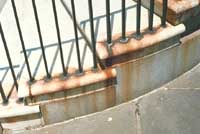
Chemical reaction between new concrete steps and historic iron railing that causes unsightly appearance. |
Using
a substitute material for the replacement part that does not convey
the visual appearance of the surviving parts of the building or
landscape, or that is physically, chemically, or ecologically incompatible.
|
|
Setting
|
....Replace
|
 |
|
recommended.....
|

|
| |
Replacing
in kind an entire feature of the building or landscape that is too
deteriorated to repair-- when the overall form and detailing are
still evident --using the physical evidence as a model to guide
the new work.
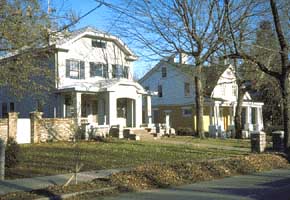
Deteriorated
porch steps and stone garden wall replaced in kind to help
unify a streetscape. |
If using the same kind of material is not technically
or economically feasible, then a compatible substitute material
may be considered.
|
|
not
recommended.....
|

|
| |
Removing
a feature of the building or landscape that is unrepairable and
not replacing it; or replacing it with a new feature that does not
convey the same visual appearance.
|
| |
Design
for Missing Historic Features
The
following work is highlighted to indicate that it represents the
particularly complex technical or design aspects of rehabilitation
projects and should only be considered after the preservation concerns
listed above have been addressed.
|
|
recommended.....
|

|
| |
Designing
and constructing a new feature of the building or landscape when
the historic feature is completely missing, such as row house steps,
a porch, a streetlight, or a terrace. It may be a restoration based
on documentary or physical evidence; or be a new design that is
compatible with the historic character of the setting.
|
|
not
recommended.....
|

|
| |
Creating
a false historical appearance because the replaced feature is based
on insufficient documentary or physical evidence.
Introducing
a new building or landscape feature that is out of scale or otherwise
inappropriate to the setting's historic character, e.g., replacing
picket fencing with chain link fencing.
|
| |
Alterations/Additions
for the New Use
The
following work is highlighted to indicate that it represents the
particularly complex technical or design aspects of rehabilitation
projects and should only be considered after the preservation concerns
listed above have been addressed.
|
|
recommended.....
|

|
| |
Designing
required new parking so that it is as unobtrusive as possible, thus
minimizing the effect on the historic character of the setting.
"Shared" parking should also be planned as that several businesses
can utilize one parking area as opposed to introducing random, multiple
lots.
Designing
and constructing new additions to historic buildings when required
by the new use. New work should be compatible with the historic
character of the setting in terms of size, scale design, material,
color, and texture. Removing
nonsignificant buildings, additions or landscape features which
detract from the historic character of the setting.
|
|
not
recommended.....
|

|
| |
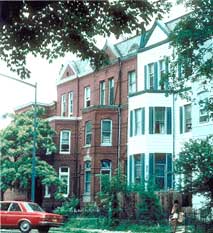
Urban setting marred by inappropriately altered house on right, now clad in vinyl siding. |
Placing
parking facilities directly adjacent to historic buildings which
cause damage to historic landscape features, including removal of
plant material, relocation of paths and walkways, or blocking of
alleys.
Introducing
new construction into historic districts that is visually incompatible
or that destroys historic relationships within the setting.
Removing
a historic building, building feature or landscape feature that
is important in defining the historic character of the setting.
|
|

